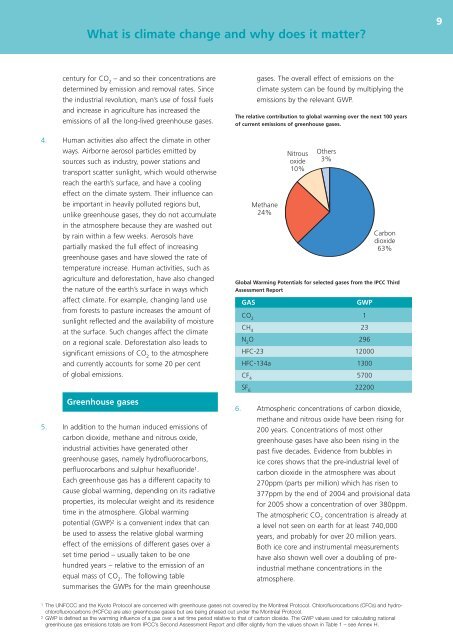UK Climate Change Programme 2006 - JNCC - Defra
UK Climate Change Programme 2006 - JNCC - Defra
UK Climate Change Programme 2006 - JNCC - Defra
You also want an ePaper? Increase the reach of your titles
YUMPU automatically turns print PDFs into web optimized ePapers that Google loves.
What is climate change and why does it matter?<br />
9<br />
century for CO 2<br />
– and so their concentrations are<br />
determined by emission and removal rates. Since<br />
the industrial revolution, man’s use of fossil fuels<br />
and increase in agriculture has increased the<br />
emissions of all the long-lived greenhouse gases.<br />
4. Human activities also affect the climate in other<br />
ways. Airborne aerosol particles emitted by<br />
sources such as industry, power stations and<br />
transport scatter sunlight, which would otherwise<br />
reach the earth’s surface, and have a cooling<br />
effect on the climate system. Their influence can<br />
be important in heavily polluted regions but,<br />
unlike greenhouse gases, they do not accumulate<br />
in the atmosphere because they are washed out<br />
by rain within a few weeks. Aerosols have<br />
partially masked the full effect of increasing<br />
greenhouse gases and have slowed the rate of<br />
temperature increase. Human activities, such as<br />
agriculture and deforestation, have also changed<br />
the nature of the earth’s surface in ways which<br />
affect climate. For example, changing land use<br />
from forests to pasture increases the amount of<br />
sunlight reflected and the availability of moisture<br />
at the surface. Such changes affect the climate<br />
on a regional scale. Deforestation also leads to<br />
significant emissions of CO 2<br />
to the atmosphere<br />
and currently accounts for some 20 per cent<br />
of global emissions.<br />
Greenhouse gases<br />
5. In addition to the human induced emissions of<br />
carbon dioxide, methane and nitrous oxide,<br />
industrial activities have generated other<br />
greenhouse gases, namely hydrofluorocarbons,<br />
perfluorocarbons and sulphur hexafluoride 1 .<br />
Each greenhouse gas has a different capacity to<br />
cause global warming, depending on its radiative<br />
properties, its molecular weight and its residence<br />
time in the atmosphere. Global warming<br />
potential (GWP) 2 is a convenient index that can<br />
be used to assess the relative global warming<br />
effect of the emissions of different gases over a<br />
set time period – usually taken to be one<br />
hundred years – relative to the emission of an<br />
equal mass of CO 2<br />
. The following table<br />
summarises the GWPs for the main greenhouse<br />
gases. The overall effect of emissions on the<br />
climate system can be found by multiplying the<br />
emissions by the relevant GWP.<br />
The relative contribution to global warming over the next 100 years<br />
of current emissions of greenhouse gases.<br />
Global Warming Potentials for selected gases from the IPCC Third<br />
Assessment Report<br />
GAS<br />
Methane<br />
24%<br />
Nitrous<br />
oxide<br />
10%<br />
Others<br />
3%<br />
GWP<br />
CO 2<br />
1<br />
CH 4<br />
23<br />
N 2<br />
O 296<br />
HFC-23 12000<br />
HFC-134a 1300<br />
CF 4<br />
5700<br />
SF 6<br />
22200<br />
Carbon<br />
dioxide<br />
63%<br />
6. Atmospheric concentrations of carbon dioxide,<br />
methane and nitrous oxide have been rising for<br />
200 years. Concentrations of most other<br />
greenhouse gases have also been rising in the<br />
past five decades. Evidence from bubbles in<br />
ice cores shows that the pre-industrial level of<br />
carbon dioxide in the atmosphere was about<br />
270ppm (parts per million) which has risen to<br />
377ppm by the end of 2004 and provisional data<br />
for 2005 show a concentration of over 380ppm.<br />
The atmospheric CO 2<br />
concentration is already at<br />
a level not seen on earth for at least 740,000<br />
years, and probably for over 20 million years.<br />
Both ice core and instrumental measurements<br />
have also shown well over a doubling of preindustrial<br />
methane concentrations in the<br />
atmosphere.<br />
1 The UNFCCC and the Kyoto Protocol are concerned with greenhouse gases not covered by the Montreal Protocol. Chlorofluorocarbons (CFCs) and hydrochlorofluorocarbons<br />
(HCFCs) are also greenhouse gases but are being phased out under the Montréal Protocol.<br />
2 GWP is defined as the warming influence of a gas over a set time period relative to that of carbon dioxide. The GWP values used for calculating national<br />
greenhouse gas emissions totals are from IPCC’s Second Assessment Report and differ slightly from the values shown in Table 1 – see Annex H.
















